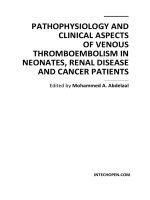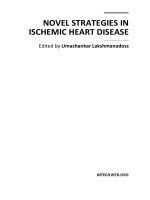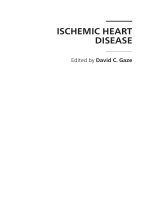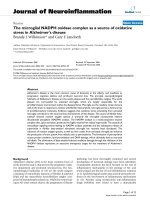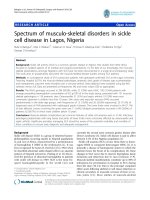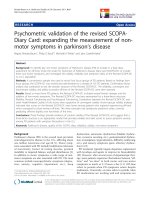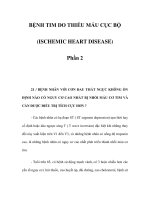Transplantation of skeletal myoblast in ischemic heart disease 2
Bạn đang xem bản rút gọn của tài liệu. Xem và tải ngay bản đầy đủ của tài liệu tại đây (1.73 MB, 220 trang )
- 1 -
CHAPTER I INTRODUCTION
SECTION I ISCHEMIC HEART DISEASE
1.1.1 Introduction to Ischemic Heart Disease
Ischemic heart disease (IHD) is receiving a continuously growing interest because of
the increased prevalence and incidence. In USA, based on Heart Disease and Stroke
Statistics Updates 2006, American Heart Association, the prevalence for IHD in 2003
was around 13,200,000. The incidence of IHD is around an estimated 1,200,000/year,
with approximately 700,000 new and 500,000 recurrent cases. It is estimated that an
additional 175,000 cases of silent first heart attack occur each year. In Singapore,
IHD ranks the 3rd most prevalent cause of hospitalization (3.7% in total
hospitalizations) according to statistics from Ministry of Health, Singapore. The
magnitude of the problem is expected to be even further amplified in the forthcoming
years because of the aging population and paradoxically, the improved postinfarction
survival rates resulting from recent pharmacological and interventional treatment.
IHD is mainly caused by atherosclerosis, a process in which fatty deposits (atheroma)
accumulate in the cells lining the wall of the coronary arteries. When more than 50%
of the luminal diameter decreases (75% decrease of luminal area), it results in
ischemia. Complete occlusion of the blood vessel results in a myocardial infarction
(MI), characterized by compromised coronary blood flow, massive cardiomyocyte
death and impaired left ventricle contractile function. Based on the 44 year follow-up
of the National Heart, Lung, and Blood Institute’s Framingham Heart Study, IHD
- 2 -
remains the leading cause of congestive heart failure (CHF).When patients with IHD
also have an IHD-leading CHF, it is described as ischemic cardiomyopathy. The
pathophysiology that follows an IHD and eventually leads to ischemic
cardiomyopathy is very profound. Initially, there is a massive death of
cardiomyocytes because of acute, severe ischemia. In the acute setting, loss of
cardiomyocytes reduces overall ventricular pump function. This reduces blood
pressure and cardiac output, which activates sympathetic nervous system as well as
the rennin-angiotensin-aldosterone system. In the short term, these factors attempt to
restore cardiac output and blood pressure. However, if sustained, neurohormonal
activation and increased mechanical stresses conspire in a maladaptive process.
Within the healing infarct area, ischemia resistant fibroblasts are recruited and
eventually replace the dead cardiomyocytes, leading to areas of fibrosis.
Unfortunately, this process does not improve any heart contract function. In an
attempt to compensate for the decrease of the heart function, a process so called
cardiac remodeling occurs. Importantly, in the post infarct heart, the remodeling
process affects not only regions of infarction but also previous normally perfused
myocardium. The situation can be even worse in ischemic cardiomyopathy because
non-infarcted regions can be supplied by stenosed coronary arteries so that active
myocardial ischemia can influence the remodeling process. In this process,
compensatory mechanism in response to a loss of functioning contractile units
includes cardiomyocyte hypertrophy and elongation, extracellular matrix exchanges,
and subcellular remodeling etc. However, none of them regenerates contractile tissue
and further compensates for the heart performance.
- 3 -
1.1.2 Current Status on IHD Treatment
Therapeutic interventions for IHD include behavioral and dietary modifications,
pharmacological therapies (including anti-platelet agents, nitrates, β-blockers,
angiotensin-converting enzyme inhibitors, angiotensin II receptor blockers, and
calcium channel blockers etc), and invasive revascularization procedures such as
coronary artery bypass grafting (CABG) and percutaneous coronary intervention
(PCI). Although significant advances have reduced the mortality of IHD, the number
of cardiac interventions continues to grow. In 2003, a total of 1.4 million inpatient
cardiac revascularizations, 664,000 PCI procedures and 467,000 CABG procedures
were performed in USA alone (Heart Disease and Stroke Statistics Updates 2006,
American Heart Association). PCI is the most common treatment option for single
vessel disease as well as simple multi-vessel disease. However, high rate of restenosis
is still a major disadvantage and limits the application in selected cases. Most recently,
the development of drug-eluting stents seems to solve the problem of recurrent
restenosis. CABG is mostly recommended for patients with complex and life
threatening IHD. The in-hospital mortality rate for CABG is 1-3% at many institutes.
Despite the risk of vein graft failure, it remains the only form of therapy that has been
shown to improve the life expectancy of patients with severe IHD. However, though
various effective treatments are available, IHD remains a leading cause of death
worldwide. IHD caused one of every five deaths in the United States in 2003. For
those NYHA class 4 patients, the mortality is still unacceptably high at 60%/year
(The Journal of the American Medical Association). In Singapore, IHD stands the
- 4 -
2nd contributing cause of death (18.1% in total deaths). The prevalence and the
mortality of the disease are calling for new approaches in the treatment of IHD.
1.1.3 No-option Patients: a Target Population for Cell Therapy
PCI and CABG are effective at relieving symptoms and improving outcomes in
patients with IHD. However, some patients with symptomatic IHD are no longer
candidates for PCI or CABG, or have exhausted or failed these modalities. A
significant number of patients (5-21%) with ischemic heart disease are not optimal
candidates for revascularization (PCI/CABG, McNeer et al.1974; Jones et al. 1983;
Atwood et al. 1990; Feyter PJ 1992; Mukerjee et al. 1999), and many have residual
angina despite maximal medical therapy. A recent study of 500 patients at Cleveland
Clinic showed that about 12% patients (59 cases) were considered ineligible for
revascularization (Mukherjee et al. 2001). The different estimates of the magnitude of
the problem may be attributed to wide regional and institutional variability in
treatment patterns of coronary disease including more or less aggressive
revascularization practices. The conditions resulting in no-option status include
recurrent in-stent restenosis, prohibitive expected failure, chronic total occlusion,
poor targets for CABG/PCI, saphenous graft total occlusion, degenerated saphenous
vein grafts, no conduits aorta, and comorbidities etc (McNeer et al.1974; Jones et al.
1983; Atwood et al. 1990; Feyter PJ 1992; Mukerjee et al. 1999; Mukherjee et al.
2001).
However, no-option patients are a heterogeneous group there are two different
clinical patterns in this population. The first group includes patients with a substantial
- 5 -
amount of viable myocardium, in whom angina is the predominant symptom
(Rizzello et al. 2004; Di Carli et al. 1998). On the other hand, the second group
includes patients with limited or no myocardial viability, in whom heart failure
symptoms predominate. This group has a poorer response to increased myocardial
perfusion (Rizzello V et al. 2005). The current management strategies for these
patients are limited. The treatment of these patients is also a moving target since
advances in interventional and surgical techniques have helped improve their quality
of life. In addition, the development of various procedures such as endovascular
cardiopulmonary bypass (Reichenspurner et al. 1998), rotational atherectomy for
calcified undilatable lesions (Madina et al. 2003), and distal protection for vein graft
interventions (Lev et al. 2004) has made possible the treatment of many patients
previous deemed to be no-option. Thus before the definition of patients with no-
option, consideration of advanced intervention is warranted. If all these options are
exhausted, then patients are deemed truly without any options and alternative
treatment strategies are needed.
1.1.4 Patients with End-stage Ischemic Cardiomyopathy: Another
Target Population for Cell Therapy
In the setting of ischemic cardiomyopathy, profound cardiac remodeling occurs,
which affects not only regions of infarcted myocardium, but also normally perfused
myocardium. The impact is really broad, affecting molecular, biochemical, metabolic,
cellular, extracellular matrix and ventricular structural characteristics. This process is
driven by increased mechanical stresses, in the form of increased preload and
- 6 -
afterload, as well as abnormally elevated levels of cytokines and neurohormones.
Different from mechanism of normal heart failure, ischemic cardiomyopathy has
large quantity of cardiomyocyte loss and severely impaired heart function. It is not
surprising that treatment of these patients with medical management alone is dismal,
especially those with advanced cardiac dysfunction (ejection fraction [EF] <30%-
35%). Franciosa et al demonstrated 80% mortality over 3 years (Franciosa et al.
1983). Until 1990’s, clinical experiment with CABG in advanced ischemic
cardiomyopathy was developed. Though EF after operation did increase to some
extent, the hospital mortality is relatively high, from 5.3% to 20% (Luciani et al. 1993;
Kaul et al. 1996; Elefteriades et al. 1997). It seems that revascularization alone is not
satisfied enough. It was commonly held that the end-stage failing heart was
irreversibly dilated, hypertrophic and dysfunctional. Until the early 1990’s, after
introduction of left ventricular assist devices (LVAD), it was appreciated that these
abnormalities were not permanent, but could be reversed, at least to some extent
(Barbone et al. 2001). Now the goal of many ischemic cardiomyopathy treatments is
to slow or reverse this process. In particular the concept of reverse remodeling is an
important principle for new treatment of heart failure.
1.1.5 The Challenges: Regenerate Contractile Tissue and Reverse
Remodeling by Cell Transplantation?
1.1.5.1 Rationale for Cell Transplantation
Cell transplantation for cardiac repair is based on two major assumptions: (a)
cardiomyocytes that generate the contractile force are responsible for the cardiac
- 7 -
output, and when large quantities of cardiomyoctyes have been irreversibly lost, heart
function deteriorates and (b) when the area of dysfunctional myocardium is
repopulated with a new pool of contractile cells, heart performance could thus be
improved. The overall objective of heart cell therapy is to repopulate postinfarction
scar tissue with contractile cells, which replace dead cardiomyocytes in sufficient
numbers and restore functionality in these akinetic areas.
Conceptually, this objective can be achieved through three distinct approaches. The
first approach is to stimulate the intrinsic regenerative capacity of heart. Initially,
heart has been considered as an organ composed of terminally differentiated
myocytes incapable of regeneration. However, the dogma is being challenged by
recent studies, showing a certain degree of cardiomyocyte regeneration in various
pathologic conditions, such as heart failure (Kajstura et al, 1998), orthotopic heart
transplantation (Müller et al., 2002; Quanini, et al., 2002), or myocardial infarction (D.
Orlic, et al., 2001; Beltrami et al, 2001), and even surmising the existence of resident
cardiac stem cells (Anversa et al., 2002), or cardiomyocyte progenitor cells
(Laflamme et al., 2002). Nevertheless, although heart has some regenerative capacity,
it is by far too limited to compensate for the loss of cardiac cells (Packer et al., 1992;
Mann et al. 1999). Furthermore, the mechanism of cardiomyocyte proliferation and
regeneration is obviously not well studied. The second strategy is based on gene
therapy and is targeted at the transformation of in-scar fibroblasts into contractile
cells by transfection with the MyoD master gene which controls the skeletal muscle
differentiation program. Although this approach has yielded some successful
experimental results (Tam et al. 1995), it is fraught with the multiple issues associated
- 8 -
with gene therapy and is still of limited clinical relevance. The third approach is to
provide exogenously contractile cells as surrogate cardiomyocytes into the scar. From
a clinical standpoint, this ‘transplantation’ strategy is likely the most realistic and,
consequently, has been extensively investigated in preclinical and clinical settings.
1.1.5.2 The Challenges for a Successful Cell-based Cardiac Repair
The path to develop successful cell therapy for cardiac repair is faced with many
challenges (Figure 1.1). The challenge begins with choosing a suitable cell type.
Many different types are being investigated, each type having its own theoretical
advantages and disadvantages (Caplice NM. 2006). Up to date, there are no criteria of
choosing suitable cells for cardiac repair. The criteria need further preclinical and
clinical trials and should be evidence-based. Apart from cell type, cells need to be
scaled up to a sufficient quantity (Pouzet et al, 2001; Tambara et al, 2003). The whole
left ventricle have a cell population of about 4.5-5.8 billion (Olivetti G et al., 1995).
In patients with ischemic cardiomyopathy it is possible that as much as 30% of the
original cardiomyocyte number is lost (Beltrami et al., 1994). Thus even if the goal
were to replace a relatively small fraction of lost myocardium, there is a need to
propagate large quantities of cells to get a beneficial effect, since a larger size of graft
would probably lead to greater benefit for the treatment of damaged myocardium. In
order to get the best retention and cell survival, many delivery strategies have been
tried in different models (Siepe M et al, 2005). Furthermore, in order to get better
survival and suitable environment for differentiation, the cells need to be
appropriately provided with nourishment via restored blood circulation. In order to
- 9 -
contract most effectively, the grafted cells need to have an electrical or mechanical
link between grafted cells and native myocytes so that they could contract in
synchrony with native myocardium (Siepe M et al, 2005). Moreover, the contraction
benefit should be sufficient enough to produce a meaningfully influence on global
ventricular performance, and further to be translated into clinically beneficial effects
on patients. In addition, it is ideal if the grafted cells could limit the scar formation
and induce beneficial effects on the ventricular structure so that the ventricular
remodeling could be reversed in the long run (Menasché P, 2007).
Figure 1.1 Challenges to a successful cell therapy for cardiac repair.
Enhanced cardiac performance,
Reverse cardiac remodeling
Identify and isolate suitable cell type
Lar
g
e scale-u
p
of selected cells
Cell retention and survival
Contraction a
pp
aratus / An
g
io
g
enesis
Electrical or Mechanical link
Beneficial effects on
p
atient si
g
ns/s
y
m
p
toms/mortalit
y
- 10 -
SECTION II: STEM CELL SOURCES AND DELIVERY
The concept of cellular transplantation to augment the function of the failing heart has
been translated to clinic. However, there are many questions left to be answered. Here
we briefly review the choice of donor cells and cell delivery strategies.
1.2.1 The Choice of Donor Cells
From a conceptual view, the ideal cell for transplantation has to meet several criteria:
they should be easy to collect and propagate in vitro, relatively tolerant to ischemia so
as to survive in the ischemic and scar tissue, capable of proliferation and myogenic
differentiation, electromechanically couple with the adjacent cells and they should not
be burdened with ethical and immunological problems (Siepe M et al, 2005).
Unfortunately, no ideal cell type could satisfy all these demands so far.
1.2.1.1 Fetal or Neonatal Cardiomyocytes
It seems logical that cardiomyocytes would be the best cell type to repair infarcted
myocardium. However, cardiomyocyte proliferation is strictly regulated by
developmental control mechanisms, and most cells withdraw from the cell cycle and
become post-mitotic after embryonic stage. But recently some investigators have
challenged the dogma and shown cardiomyocyte replication (Kajstura et al. 1998;
Müller et al., 2002; Quanini et al., 2002; Orlic et al., 2001; Beltrami et al., 2001;
Anversa et al., 2002; Laflamme et al., 2002; Packer 1992; Mann et al., 1999).
Unfortunately, the regenerative capacity of myocardium seems inadequate to
- 11 -
compensate for the tissue loss. Due to poor proliferation of adult cardiomyocytes in
vitro, cardiomyocytes from fetal or neonatal sources have to be used.
Transplanting fetal or neonatal myocytes was initially regarded as the primary model
of cellular cardiomyoplasty. When transplanted, suspension of cultured fetal
cardiomyocytes in mice (Soonpaa et al., 1994), and fetal or neonatal cardiomyocytes
in rat hearts (Reinecke et al. 1998) formed the viable grafts over 2 months in normal
myocardium of syngeneic hosts. Electron microscopy study showed the formation of
intercalated disks and tight junctions between grafted fetal cardiomyocytes and host
myocardium after transplantation (Soonpaa et al., 1994). Furthermore, in infarcted
myocardium, viability of engrafted cells was demonstrated for up to 6–7 months after
transplantation of fetal and neonatal cardiomyocytes in a permanent coronary-
occlusion rat model (Müller et al., 2002). However, the initial enthusiasm generated
by the above studies died down when it was shown that fetal cardiomyocytes are
highly sensitive to ischemia, and massive cell death prevents the formation of enough
new myocardium to replace the infarct, and the therapeutic use of fetal
cardiomyocytes might ultimately require additional interventions (Zhang et al., 2001;
Muller et al., 2002; Reinecke et al. 1999). Moreover, use of fetal cardiomyocytes also
faces immunological problems as well as ethical difficulties in human application.
These problems prompted the search of alternative cell sources for cardiac repair.
1.2.1.2 Myocardial Stem Cells
Despite the generally accepted dogma that adult cardiomyocytes are unable to
regenerate, recent research suggests the existence of cardiac stem cells (CSCs, Table
- 12 -
1.1). Studies on human hearts shortly after myocardial infarction demonstrated a
small proportion of cardiomyocytes (0.08%) apparently undergoing mitosis in the
peri-infarct tissue (Beltrami et al., 2001). This paper challenged the dogma that the
adult heart is a terminally differentiated organ and suggested that there may be a
population of CSCs involved in myocardial regeneration. Subsequently, from the
adult rat heart, they isolated cells that expressed stem cell maker “c-kit” in 2003
(Beltrami et al., 2003). These cells had some characteristics of stem cells including
self-renewing, clonogenicity, and multipotency. When injected into an ischemic heart,
the cells differentiated into cardiomyocytes, smooth muscle cells and vascular
endothelium, producing new myocardium and new vessels that replaced the majority
of the infarcted tissue and contributed to improved ventricular contraction. It is of
translational interest that these cells traversed the vascular barrier and improved
ventricular function in a rat infarct model when delivered via the intracoronary route,
reported by Dawn et al. recently (Dawn et al., 2005). In 2004, Messina E et al isolated
and expanded adult CSCs from atrial or ventricular human specimens and from
murine hearts. CSCs were also shown to be present in patients with aortic stenosis
and ischemic cardiomyopathy (Urbanek et al., 2003; 2005). Because CSCs are normal
components of the adult heart and appear to be responsible for the physiologic and
pathologic turnover of cardiac myocytes and non-myocytes, they may be particularly
suitable for reconstituting dead myocardium.
13
Table 1.1 Cardiac Progenitor Cells so far Identified and Their Characteristics
Cell type Species Phenotype Clonogenic Multipotent In vitro differentiation In vivo differentiation
Cardiosphere
formation
c-kit
+
Beltrami et al.
Dawn et al.
Rat,
dog
c-kit
+
Lin
-
CD34
-
CD45
-
Yes Yes Incomplete, into cardiomyocytes,
endothelial cells and smooth
muscle cells
Cardiomyocytes, endothelial
cells and smooth muscle cells
organized in capillaries
Yes
c-kit
+
Messina et al.
Mouse,
human
c-kit
+
Sca-1
+
CD31
+
CD34
+
KDR/Flk-1
+
Yes Yes Cardiomyocytes, endothelial cells Cardiomyocytes, endothelial
cells and smooth muscle cells
organized in capillaries
Yes
c-kit
+
Urbanek et al
human c-kit
+
Sca-1
+
MDR1
+
Negative for
hemopoietic
antigens
NA Yes NA Cardiomyocytes, endothelial
cells and smooth muscle cells
NA
Sca-1
+
Oh H et al.
Mouse Sca-1
+
Lin
-
c-kit
-
CD34
-
CD45
-
Yes Yes cardiomyocytes, Cardiomyocytes Yes
Sca-1
+
Matsuura et al.
Mouse Sca-1
+
c-kit
+
CD34
+
CD45
+
Yes Yes Cardiomyocytes NA Yes
SP
Martin et al.
Mouse ABCG2
+
c-kit
+
Sca-1
+
CD34
+
CD45
+
NA NA Cardiomyocytes NA Yes
SP
Pfister et al.
Mouse Sca-1
+
CD31
-
NA NA Cardiomyocytes NA NA
Isl-1
+
Laugwitz et al.
Mouse,
rat,
human
Isl-1
+
c-kit
-
Sca-1
-
NA NA Cardiomyocytes Cardiomyocytes NA
UPCs
HC Ott et al.
Rat SSEA-1
+
Yes Yes Crdiomyocytes, endothelial cells
and smooth muscle cells
Cardiomyocytes, endothelial
cells
NA
UPCs: uncommitted cardiac precursor cells. SSEA-1: stem cell marker stage-specific embryonic antigen 1. ABCG2+: ATP-binding cassette
transporter. Isl-1+: insulin gene enhancer binding protein. c-kit: receptor for the stem cell factor. Sca-1: stem cell antigen 1. MDR1+: P-
g
l
y
co
p
rotein. Lin: Linea
g
e markers. KDR/Flk-1+: vascular endothelial
g
rowth factor rece
p
tor.
13
14
In addition to c-kit
+
cells, several other populations of cardiac progenitor cells have
been described with cardiomyogenic potential. In 2003, Oh et al identified Sca-1+
cardiac progenitors that expressed CD31 but not c-kit or other markers of
hematopoietic or endothelial progenitors (Oh et al., 2003). When these cells were
subjected to DNA demethylation by 5-azacytidine treatment, they activated several
cardiac-specific genes in vitro. When injected intravenously into a mouse with
myocardial infarction, the engrafted Sca-1+ cells expressing cardiac markers
(sarcomeric, actin and troponin I) were found to generate cardiomyocytes, both with
and without cell fusion. These cells differed from those described by Beltrami et al in
that they consistently express Sca-1 but not c-kit. Subsequently, another type of Sca-
1+ cardiac progenitor cells (Matsuura et al, 2004) was identified from adult murine
hearts by a magnetic cell sorting system. These cells co-expressed CD45 (40%) and
CD34 (10%). When treated with oxytocin, Sca-1+ cells expressed genes of cardiac
transcription factors and contractile proteins and showed sarcomeric structure and
spontaneous beating. These results suggest that Sca-1+ cells in the adult murine heart
have potential as stem cells and may contribute to the regeneration of injured hearts.
Martin and colleagues isolated an Abcg2-expressing cardiac side population (SP)
cells from embryonic as well as adult mouse hearts (Martin et al, 2004). They
reported that, when co-cultured with unfractionated cardiac cells, some of the cardiac
side population cells began to express the sarcomeric protein (actinin). Interestingly,
these cardiac SP cells were negative for CD31. To our knowledge, in vivo
transplantation studies with cardiac side population cells have not been reported.
15
In yet another progenitor population is the cells expressing the LIM-homeodomain
transcription factor islet-1 (isl1). During development, isl-1+ cells contributed
substantially to the right ventricle, atria, outflow tracks and part of the left ventricle
(Cai et al., 2003). Building on this work, later study has shown that isl-1+ cells were
present in the neonatal heart, without expressing c-kit (Laugwitz et al, 2005). These
cells exhibited a cardiomyocyte phenotype when cocultured with neonatal
cardiomyocytes in vitro and showed electrical as well as contractile properties
reminiscent of neonatal cardiomyocytes. Interestingly, cardiomyocyte cultures fixed
in formaldehyde still induced cardiac differentiation of the isl1+ cells, effectively
ruling out fusion as an explanation for activation of the cardiac program. Despite
these findings, however, it should be emphasized that the cells studied by Laugwitz et
al were isolated from neonatal hearts; it is unknown whether cells with the same
properties can be isolated from the adult heart as well (a critical issue from the
standpoint of therapeutic application).
The most recent candidate progenitor cell population is uncommitted cardiac
precursor cells (UPCs, Ott et al., 2007). The cells were characterized by expression of
the embryonic stem cell marker stage-specific embryonic antigen 1 (SSEA-1). When
highly enriched populations of suspended UPCs were expanded over a cardiac-
derived mesenchymal feeder layer, temporal maturation of the original suspended
cells from an uncommitted SSEA-1+ was observed state to a mesodermally
committed flk-1+ state, then to an flk-1+ and sca-1+ state and then to a cardiac
committed nkx2.5+, GATA-4+, or isl-1+ state. Ultimately, cells differentiated into
mature cardiomyocytes, endothelial cells, and smooth muscle cells. As compared to
16
the aforementioned sca-1+, c-kit+, isl-1+ or SP cardiac precursors, UPCs appeared
to resemble the more immature, common pool of embryonic lateral plate mesoderm
progenitors that yielded both myocardial and endocardial cells during normal cardiac
development. Under controlled in vivo conditions, these cells could differentiate into
endothelial, smooth muscle, and cardiomyocyte lineages. Since these cells could be
isolated and expanded to clinically relevant numbers from adult rat myocardial tissue,
they would be a promising population to test in cardiac repair applications.
At present, the relationship among the various cardiac progenitor cells outlined above
is unclear. Nevertheless, the discovery of resident cardiac progenitors represents a
momentous milestone in cardiac biology, for it refutes the long-held view of the heart
as a terminally differentiated organ. Instead, it supports a new paradigm in which the
heart is a self-renewing organ that undergoes a continuous turnover. The cardiac
progenitor cell revolution has shown that the heart is not different from other organs,
in which repositories of stem/progenitor cells have been reported for many years.
1.2.1.3 Embryonic Stem (ES) cells
Derived from the inner cell mass of blastocysts, the ES cells have the pluripotent
nature, capacity of self-regenerating, well-established protocols for their derivation,
propagation and differentiation, which provides another potential source of cells for
cardiomyoplasty (Evans et al., 1981; Martin 1981).
In 1988, Doetschman et al showed ES cells underwent spontaneous formation of
three-dimensional “embryoid bodies" which included foci of beating myocardium
(Doetschman et al. 1988). However, cardiogenesis within embryoid bodies is
17
relatively inefficient. Using genetic selection method, cardiomyocytes with >99%
purity were obtained by Klug et al. (1996). Later, this selection strategy has been
adopted for large-scale production of highly purified ES cell-derived myocytes
(Zandstra et al. 2003). Cardiomyocyte-like cells obtained by similar approaches were
characterized by immunohistology for troponin-T (Metzger et al., 1996), troponin I
(Westfall et al. 1996), gap junction protein connexin-43 (Oyamada et al., 1996), α-
cardiac-myosin heavy chain (Maltsev et al., 1993; Kolossov et al., 2005), myosin
light chain (Meyer et al., 2000), Nkx2.5 (Hidaka et al., 2003); and functionally with
regard to Ca2+ signaling (Sauer et al., 2001). These findings demonstrated that ES
cells provide an enormous potential for cell-based cardiac repair. In 1996, Klug et al.
demonstrated that direct transplantation of mouse ES cell−derived cardiomyocytes
into an immunocompatible recipient heart resulted in the successful formation of
stable intracardiac grafts. Subsequently, the transplantation efficacy of mouse ES cell
have been confirmed by other investigators (Behfar et al., 2002; Etzion et al., 2001;
Min et al., 2002; Min et al., 2003).
The generation of human ES lines with a stable developmental potential was firstly
described by two groups (Thomson et al., 1998; Reubinoff et al., 2000). Subsequently,
several studies have established spontaneous and directed differentiation systems
from human ES cells into cardiac tissue (Kehat et al., 2001; Xu et al., 2002;
Mummery et al., 2003; He et al., 2003). These human ES cell−derived
cardiomyocytes showed the expected molecular, structural, electrophysiologic and
contractile properties of early stage human cardiomyocytes. In addition, the capability
of differentiation into endothelial cells was recently demonstrated (Levenberg et al.,
18
2002). As compared with mouse counterparts, in vivo transplantation of human ES
cell-derived cardiomyocytes is in infancy. In 2004, Kehat et al. described the
generation of a reproducible cardiomyocyte differentiation system from human ES
cells, and the generated myoctyes displayed functional and electromechanical
integration with host myocardium (Kehat et al. 2004). In 2005, Xue et al. also
demonstrated functional integration of electrically active cardiac derivatives from
genetically engineered human embryonic stem cells with recipient myocardium (Xue
et al. 2005). These two studies used electrical mapping techniques to show an ectopic
pacemaker site where human ES cell−derived cardiomyocytes were implanted, and
unambiguously demonstrated host-graft electromechanical coupling. These promising
results have led to an exploding increase in this field of research.
Despite of the development of the human ES cell technology, unresolved ethical and
political issues, concerns about the tumorigenicity of the cells, and the need to use
allogeneic cells for transplantation currently hamper their use in clinical application.
Furthermore, protocols for large-scale production of highly purified preparations of
cardiomyocytes need to be optimized. Human ES cell−derived myocytes should be
up-scaled to yield clinically relevant number of cells, and should be highly purified to
avoid electrophysiological disorders (He et al., 2003)
1.2.1.4 Bone Marrow Derived Stem Cells
Currently the vast majority of clinical studies using stem cells for cardiac repair are
based on bone marrow derived stem cells (BMCs). It has been shown that adult bone
marrow hosts heterologous populations of multipotent cells: the hematopoietic stem
19
cells (HSCs), endothelial progenitor cells (EPCs), CD133+ cells, and mesenchymal
stem cells (MSCs).
The HSCs are precursors of blood and endothelial cells in adult bone marrow with
expression of cell maker CD34. As compared to normal HSCs, bone marrow derived
HSCs have a limited capacity for self-renewal and differentiation and can sustain
hematopoiesis for a short-term period. Previous studies have suggested
transplantation of autologous bone-marrow-derived or circulating progenitor cells
may be beneficial for post-infarction left ventricular contractile function (Orlic et al.,
2001; Jackson et al., 2001; Reinlib et al., 2000). However, several subsequent
preclinical studies using state-of-the-art genetic tools have seriously challenged the
concept that stem cells truly trans-differentiate into functional cardiomyocytes
capable of generating active force (Murry et al., 2004; Balsam et al., 2004; Nygren et
al., 2004). Despite these divergent preclinical findings, several different types of cells
have been used in clinical settings. A small population of endothelial progenitor cells
(EPCs) has originally been defined by their cell surface expression of the HSCs
marker proteins CD133 and CD34 and the endothelial marker vascular endothelial
growth factor receptor-2, and their capacity to incorporate into sites of
neovascularization and to differentiate into endothelial cells in situ (Asahara et al.,
2004). Increasing evidence suggests that when expanded in culture, EPCs also
contain a CD14+/CD34–-mononuclear cell population with angiogenic effects by
releasing paracrine factors (Rehman et al., 2003; Urbich et al., 2004). Notably, EPC
numbers and their angiogenic capacity are impaired in patients with coronary artery
disease, which may limit their therapeutic usefulness (Vasa et al., 2001; Hill et al.,
20
2003). It has been shown that CD133+ cells can integrate into sites of
neovascularization and differentiate into mature endothelial cells (Asahara et al.,
2004).
MSC is a rare population of CD34– and CD133– cells present in bone marrow stroma
(0.001%–0.01%) and other mesenchymal tissues (Pittenger et al., 2004). However,
there in no adequate cell marker to allow selection of purified cell populations, and
thus their phenotypes remain unclear. MSCs can readily differentiate into multiple
lineages (Jiang et al., 2002). Differentiation of MSCs to cardiomyocyte-like cells has
been observed in vitro under specific culture conditions and in vivo after injection
into healthy or infarcted myocardium in animals (Makino et al., 1999; Toma et al.,
2002; Mangi et al., 2003). Transplantation of MSCs enhanced regional wall motion
and prevented remodeling of the remote, non-infarcted heart (Mangi et al., 2003;
Shake et al., 2002). Moreover, cultured MSCs secreted angiogenic cytokines, which
improved collateral blood flow recovery in a murine hind limb ischemic model
(Kinnaird et al., 2004). As MSC clones have been reported of a low immunogenicity,
they might be applied in allogeneic transplantation in future clinical studies (Pittenger
et al., 2004). Importantly, if the allogeneic acceptance of MSC is applied in clinical
settings, it will greatly decrease the logistic concerns, cost and time for MSC isolation
and propagation to allow the on-shelf availability of MSCs. In addition, MSCs were
demonstrated to home into the areas of injury which may provide the possibility of
delivering the cells by intravenous route (Bittira et al., 2003).
21
To date, selected or non-selected BMCs have been widely applied in patients with
acute MI (Strauer et al., 2002; Assmus et al., 2002; Britten et al. 2003; Schachinger et
al. 2004; Fernandez-Aviles et al. 2004; Kuethe et al. 2004; Wollert et al. 2004),
myocardial ischemia without revascularization (Hamano et al. 2001; Tse et al. 2003;
Fuchs et al. 2003; Perin et al. 2003; Perin et al. 2004), and ischemic cardiomyopathy
(Stamm et al. 2003; Stamm et al. 2004; Assmus et al. 2004). These studies have
reported no significant short-term safety concerns. However, long-term toxicity
should be carefully observed due to the use of unselective BMCs. The non-selected
cells, after engraftment into myocardium, may generate severe calcification (Yoon et
al., 2004) and other non-cardiac tissues, and further led to malignant ventricular
arrhythmias. Furthermore, since non-selected cells have good generative capacity,
and may secrete angiogenic factors such as VEGF, it is possible to generate angiomas
or even tumors in the long run (Epstein et al., 2001). Thus, non-selected BMCs
should be carefully used before enough information is available in this regard.
Additionally, although the previous studies have provided positive information on the
transplantation efficacy, intermediate- sized, randomized, and well controlled trials
need to be established to evaluate the real effectiveness of BMC transplantation.
1.2.1.5 SkMs (please refer to SECTION III)
1.2.2 Cell Delivery Methods
There are various strategies for cell delivery in heart cell therapy. The goal of any cell
delivery strategy is to achieve the ideal concentration of viable cells for cardiac repair
with the lowest risk to patients. Therefore, cell-delivery strategies must take into
22
account the clinical setting and local milieu, because stem cells may perform
differently according to local signaling. The ideal delivery strategy should be safe,
easy to use, applicable to a wide range of clinical scenarios, precise in target, and
results in good cell retention. Stem cells can be delivered through coronary arteries,
coronary veins, or peripheral veins. Alternatively, direct intramyocardial injection can
be performed using a surgical, transendocardial, or transvenous approach. A delivery
strategy may involve mobilization of stem cells from the bone marrow using cytokine
therapy, with or without peripheral harvesting. Each technique has its peculiarities,
and so the choice of the modality should be based on the own clinical scenario.
1.2.2.1 Stem Cell Mobilization
In humans, mobilization of bone marrow derived stem cells occurs after AMI,
suggesting a natural attempt at cardiac repair (Shintani et al., 2001; Leone et al.,
2005). Therapeutic mobilization of bone marrow progenitor cells after AMI would
amplify the existing healing response. Granulocyte-colony stimulating factor (G-CSF)
is one of the best-studied cytokines, with relative data published in small animals,
primates, and early human trials. Several investigators have demonstrated that G-CSF
administration improves ventricular function of postinfarction in mice (Orlic et al.,
2001), rats (Sugano et al., 2005) and pigs (Iwanaga et al., 2004). On the other hand,
no beneficial effect of G-CSF in mice and baboons has been observed (Norol et al.,
2005; Deten et al., 2005). Despite these discrepancies, G-CSF treatment has already
been applied in the clinical trials (Kang et al., 2004; Kuethe et al., 2004; Kuethe et al.,
2005; Suárez et al., 2005; Jorgensen et al., 2005; Ince et al., 2005; Valgimigli et al.,
23
2005; Wang et al., 2005; Boyle et al., 2005). Stem cell mobilization is an attractive
strategy to treat heart failure because it is simple and would obviate the need for
invasive harvesting or delivery procedures. However, dissimilar to the above studies,
not all groups find G-CSF effective, particularly the two negative studies recently
reported in treating chronic ischemia (Wang et al., 2005; Boyle et al., 2005). Further,
safety concerns should be always attended because of concern about tumorigenesis
(Boyle et al., 2005).
1.2.2.2 Direct Intramyocardial Injection
Intramyocardial injection, injected through the epicardium, endocardium, or coronary
vein, has been performed in chronic myocardial ischemia (Herreros et al., 2003; Dib
et al., 2005; Siminiak et al., 2004; Pagani et al., 2003; Thompson et al., 2003; Smits et
al., 2003). In this technique, stem cells are introduced into the myocardium under
pressure using a hollow needle. This is the preferred delivery route in patients with
chronic total occlusion of coronary arteries and in clinical settings that involve
weaker homing signals, such as chronic congestive heart failure. In theory, it should
be the most suitable route for delivering larger cells, such as SkMs and mesenchymal
stem cells, which can plug capillaries. However, direct injection of cells into ischemic
or scarred myocardium creates islands of cells with limited blood supply and may
lead to poor cell survival (Murry et al., 1996; Reinecke et al., 1999; Taylor et al.,
1998; Suzuki et al., 2004; Fearon et al., 2004). Strategies that enhance graft survival
are thus mandatory to optimize the benefits of this procedure.
1.2.2.2.1 Transepicardial injection
24
Transepicardial delivery of stem cells is the most commonly used technique in
cardiac stem cell therapy. Cells are injected into infarct border zones or areas of
infarcted/scarred myocardium under direct visualization (Herreros et al., 2003; Dib et
al., 2005; Siminiak et al., 2004; Pagani et al., 2003), which performs as an adjunct to
CABG. This strategy requires thoracotomy or sternotomy and, is relatively invasive
as compared to other delivery approaches, associated with significant surgical
morbidity. In a planned open-heart surgery, the ancillary delivery of cell therapy in
this fashion can be easily justified. The main advantages of this method are its proven
safety in several preclinical and human trials (Herreros et al., 2003; Dib et al., 2005;
Siminiak et al., 2004; Pagani et al., 2003; Reinecke et al., 1999; Taylor et al., 1998;
Suzuki et al., 2004) and its ease of use. Another important advantage of this approach
is that it could provide a high level of cells per unit area injected. However, in a direct
external approach, visual assessment for infarcted border zone may be limited and not
all areas of the myocardium (e.g. the septum) can be readily reached (Thompson et al.,
2003). Furthermore, the safety of direct injection in AMI has not been tested. In
addition, the invasiveness of this approach hampers its use as a stand-alone therapy.
Conversely, the efficiency of cell transplantation may be difficult to evaluate and
ascertain if CABG is performed simultaneously. Nevertheless, direct surgical
injection might certainly have a role in the future of stem cell therapy. One can easily
envision the cardiac surgeon, during CABG , bypassing all feasible areas and then
concomitantly injecting stem cells into those areas bypass grafting are not applicable.
1.2.4.2.2 Transendocardial Injection
25
Transendocardial injection is performed using a percutaneous femoral approach.
Using an injection needle catheter advanced retrogradely across the aortic valve and
positioned against the endocardial surface, cells can be directly injected into any area
of the left ventricular wall. Up to date, four intramyocardial catheter-based delivery
systems (including the Helix
TM
[Fearon et al., 2004], the MyoCath
TM
[Bioheart Inc.,
Sunrise, FL, USA], the Myostar
TM
[Vale et al., 2000], and the Stiletto
TM
[Christman et
al., 2004; Naimark et al., 2003]) have been used in clinical trials. Among them, Helix
and MyoCath systems are integrated systems. As the tip of the device contacting the
endocardium, the core catheter is advanced, forcing a straight needle to a controlled
intramyocardial depth (3–8 mm) for cell injection. The integrated design provides a
relatively simple mechanism for navigation and repeated injections. Stiletto
TM
is
guided fluoroscopically, usually in two planes. Myostar
TM
is guided by a NOGA
system (Cordis Corp.), a catheter-based electromechanical system, providing a 3-
dimensional left ventricular electromechanical map, which represents the endocardial
surface of the left ventricle. These two systems are not integrated. With the guidance,
the system enables multiple, topographically distinct injections. As compared with
transepicardial injection, this method can be used as a stand-alone therapy and as an
adjunct therapy to CABG/PCI with minimal invasiveness.
1.2.4.2.3 Trans-coronary-vein Injection
Trans-coronary-vein injection uses a catheter system incorporating an ultrasound tip
for guidance and an extendable needle for myocardial access. To date, feasibility
studies have shown a good safety profile for this technique in experimental animals as

